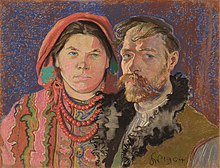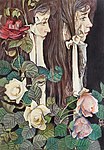Stanisław Wyspiański
Stanisław Wyspiański | |
|---|---|
Austrian Poland | |
| Died | 28 November 1907 (aged 38) Kraków, Austrian Poland |
| Nationality | Polish |
| Education | School of Fine Arts, Kraków |
| Known for | Architecture, drawing, furniture, painting |
| Movement | Art Nouveau, symbolism |
| Spouse | Teodora Teofila Wyspiańska |
Stanisław Mateusz Ignacy Wyspiański (pronounced
Wyspiański was one of the most outstanding and multifaceted artists of his time in Poland under
Biography
Stanisław Wyspiański was born to Franciszek Wyspiański and Maria Rogowska. His father, a sculptor, owned an
In 1887 Wyspiański enrolled in the Faculty of Philosophy at

The years 1890–1895 were devoted to travel. Wyspiański visited Italy,
He cooperated with the

After the success of Wesele (The Wedding) four new plays based on Polish history were published: Wyzwolenie (Liberation), Achilles, Bolesław Śmiały (Boleslaus The Bold) and Legenda II (Legend 2). The following years were devoted to publishing of Skałka and Powrót Odysa (Return of Odysseus); meanwhile Wyspiański translated Corneillea's Cyd (Le Cid) and Voltaire's Zaïre.
In 1906 Wyspiański became a professor at the Academy of Fine Arts in Kraków. He was also a member of the city council. In his last years, Wyspianski's health deteriorated. As a result, he underwent medical treatments in Rymanów and Bad Hall and then settled in his small cottage in the village of Węgrzce. He died of syphilis, which was incurable at the time. His funeral took place in Kraków and became a national day of mourning. Wyspiański was buried in the Crypt of the Distinguished in the Skałka Church.[7]
Creative output
Wyspiański's artistic output is very eclectic. Among dramas and poetry, there are views of
Drawings, such as his 1890
Using this technique, he painted many of his acquaintances and artists, among others Kazimierz Lewandowski,
Part of his output constitutes various designs – mainly
Leading stage plays
- Warszawianka (Varsovian Anthem) (1898)
- Klątwa (The Curse) (1899)
- Protesilas i Leodamia (1899)
- Meleager (1899)
- Legion (1900)
- Wesele (The Wedding) (1901)
- Wyzwolenie (Liberation) (1903)
- Weimar 1829 (fragment, 1904)
- Noc listopadowa (November Night) (1904)
- Acropolis (1904)
- Skałka (1907)
- Powrót Odysa (Return of Odysseus) (1907)
- Zygmunt August(1907 – unfinished)
Selected paintings
-
Sleeping Staś, 1904, National Museum, Poznań
-
View of Kościuszko Mound, 1904
-
Motherhood, 1905, National Museum in Kraków
-
Rudawa river, National Museum in Kraków
-
2xEliza Parenska,National Museum in Wrocław
-
Helenka,National Museum in Wrocław
Wyspiański Museum and monuments in his honor

The Stanisław Wyspiański Museum in
In 1996 a plaque for Stanisław Wyspiański was unveiled at Hotel Nordbahn (since 2008 Austria Classic Hotel Wien) at Praterstraße 72 in Vienna's Leopoldstadt, commemorating the 50th anniversary of the Österreichisch-Polnische Gesellschaft (Austrian-Polish Society) and Wyspiański's frequents stays at the hotel, where among other things he wrote his German dramatic fragment "Weimar 1829" in summer 1904.
In front of the new National Museum building in Kraków on 3-go Maja Street there is a monument to Stanisław Wyspiański. 2007 was named the Year of Stanisław Wyspiański by the
Kraków streets associated with Wyspiański
- 26 Krupnicza Street: Wyspiański was born at 26 Krupnicza Street in Kraków, in a house that belonged to his grandparents. He lived there until 1873.
- 25 Kanonicza Street: In the summer of 1873 Wyspianski's family moved to the house of Jan Długosz. Wyspiański's younger brother and mother died here. In the autumn of 1880 Wyspiański moved into the house of his uncle and aunt.
- 1 Kopernika Street: Between 1880 and 1883 he lived in the house of the Stankiewicz family, site of the later PTTKTourist House and the present Wyspiański Hotel.
- 2 Zacisze Street: Here was the Stankiewicz family's new apartment. It was on the second floor of the now non-extant Central Hotel at the junction of Zacisze and Basztowa streets, with a view onto the Planty Park. Because of the hotel's expansion, the Stankiewicz family was forced to move out in 1885.
- 1 Westerplatte Street (then Kolejowa Street): In July 1895 the Stankiewicz family began living here in an apartment on the ground floor at the corner of Kolejowa and Lubicz streets. Currently at this site there are arcades and stairs to an underground passage. At the time Wyspiański had his studio in the nearby village of Grzegórzki, where he worked on stained glass window designs for the Franciscan Church.
- 10 Poselska Street After a few months at Westerplatte Street, Wyspiański's uncle died and Wyspiański and his aunt went to live at 10 Poselska Street in a second-floor apartment.
- 9 Mariacki Square In July 1898 Wyspiański rented a room at the junction of 9 Mariacki Square and 4 Rynek Główny. In 1907 the house was taken down and replaced by an Art Nouveau tenement block. The flat was used as a studio. Wyspiański at the time was registered at 23 Szlak Street in the house of his future wife, Teofilia Pytko.

- 79 Krowoderska Street. In 1901 Stanisław Wyspiański received an award from the Wawel Royal Castle. This enabled him to rent a seven-room apartment at 79 Krowoderska Street, on the second floor, at the corner of Juliusza Słowackiego Avenue. He lived there with his family and also had a studio there. Allegedly there was a sign on his door: "Here lives Stanisław Wyspiański, who does not wish to be visited."
- Węgrzce near Kraków After another prize for landscapes depicting the Kościuszko Mound awarded by the Academy of Learning, Wyspiański moved to his own house in the village of Węgrzce (nb 5). The house, now demolished, has been replaced by another private residence. There is a stone at the site with a commemorative plaque erected on the 100th anniversary of the artist's birth.
- 1 Siemiradzkiego Street The hospital where Wyspiański died on 28 November 1907 still exists, although it operates now as a maternity hospital. It is situated on the corner of Siemiradzkiego and Łobzowska streets.
See also
- List of Polish language authors
- List of Polish language poets
- List of Polish painters
- List of Polish people (visual arts)
- National Museum, Kraków
- Young Poland
Footnotes
- ^ M. Kantor. Translated by Maya Boncza (Winter 2008). "Year of Stanislaw Wyspianski" (PDF direct download, 2.67 MB). Krakow: Alma Mater. Miesiecznik Uniwersytetu Jagiellonskiego. pp. 6–7. Retrieved 1 November 2012.
- ISSN 2210-2396.
- ISBN 978-0-520-21190-2.
- ISBN 978-90-420-0113-8.
- ^ a b "Stanisław Wyspiański". Retrieved 17 April 2020.
- ^ Ann Komaromi, "Wyspianski's Wesele: Poised on the Border," Theatre Journal – Volume 54, Number 2, May 2002, The Johns Hopkins University Press Theatre Journal 54.2 (2002) pp. 187–202, JHU.edu
- ^ "Stanisław Wyspiański (1869-1907)". Retrieved 17 April 2020.
- ^ "Stanisław Wyspiański". Retrieved 17 April 2020.
- ^ "Muzeum Stanisława Wyspiańskiego w Kamienicy Szołayskich (Kraków)". Muzea w Polsce. museo.pl. Retrieved 2 November 2012.
Bibliography
English Literature
- Zimmer, Szczepan K. (1959) Stanisław Wyspiański, Biographical Sketch, translated by Helena Maria Zimmer
Polish Literature
- Brodnicki, W. (1970) Między niebem a piekłem. Łódź: Wydawnictwo Łódzkie.
- Kępiński, Z. (1984) Stanisław Wyspiański. Warsaw: Literatura.
- Nelken, H. (1959) Stanisław Wyspiański. Warsaw: Wydawnictwo Arkady
- Skoczylas, L. (1972) Stanisław Wyspiański – życie i twórczość. Cracow: Książnica Powszechna.
German Literature
- Taborski, Roman (1996) Stanisław Wyspiański – der große Schöpfer der polnischen Moderne : anläßlich der Enthüllung der Wyspiański gewidmeten Gedenktafel in Wien (Ed.: Edward Hałoń) . Vienna: Zentrum für Verbreitung d. Wiss. d. Poln. Akad. d. Wiss.
External links
- Stanisław Wyspiański at culture.pl
- Stanisław Wyspiański at poezja.org
- Stanisław Wyspiański – The Theatre of Interiors
- R. Starzewski, The Wedding by S. Wyspiański The first review of Wesele (The Wedding Reception)
- Wyspiański's Herbal (13 April 2007 – 2 September 2007), Strona główna (Szołayski House) Exhibitions Archive of 2007, ul. Szczepańska 11
- Wyspiański Stanisław Wyspiański: Witraże at pinakoteka.zascianek.pl by Witold Raczunas. Stanisław Wyspiański: Stained-glass (1).






